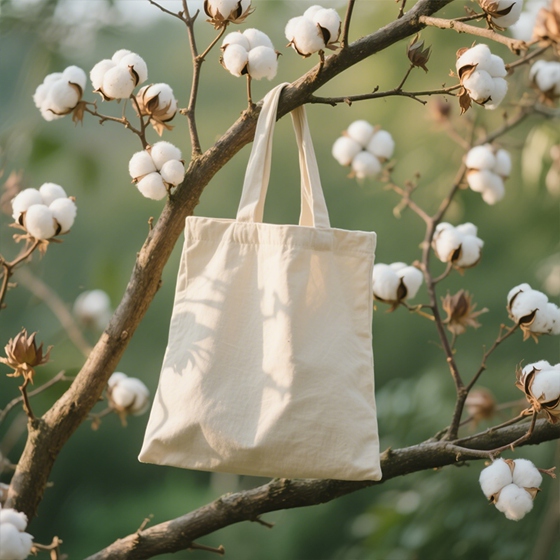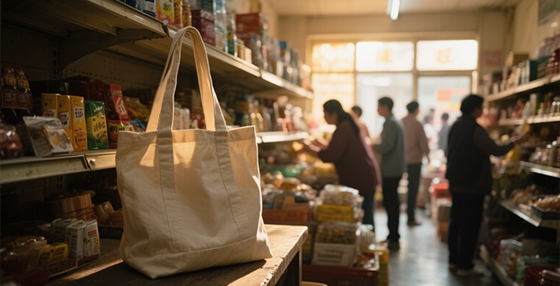Title: Are Canvas Bags Really Environmentally Friendly? The truth might be more complicated than you think!
Canvas bags have almost become synonymous with "eco-friendly living". It is strong and durable, and is a classic alternative to plastic bags. But when we shout "Bring your own canvas bag", have we ever thought: Is it really green enough from "cradle to grave"? Today, we will conduct a comprehensive analysis from raw materials to production to uncover the hidden challenges beneath the environmental halo of canvas bags.
1、Raw material source: The duality of cotton
Natural vs. high resource consumption: Canvas is mainly made of cotton and is a natural fiber. This sounds very environmentally friendly, doesn't it? However, traditional cotton cultivation is a major consumer of resources. It requires a huge amount of water (about 2,700 liters of water are needed to produce 1 kilogram of cotton!) A large amount of pesticides and chemical fertilizers. These chemical substances pollute soil and water sources and threaten biodiversity.
Dawn: Organic Cotton and Recycled Cotton: Choosing canvas bags made of organic cotton (without the use of toxic pesticides and chemical fertilizers) or recycled cotton (recycled waste cotton textiles) can significantly reduce the environmental footprint during the raw material stage. Confirming the relevant certifications is the key!

2. Production process: Energy consumption and emissions cannot be ignored. The series of industrial processes from spinning cotton into yarn, weaving it into fabric, dyeing it, printing and dyeing it, to sewing it into bales require a large amount of energy (electricity, fossil fuels) and water.
3. Pollution risks in dyeing and post-treatment: Traditional dyeing processes use a large amount of chemical dyes and auxiliaries. If the wastewater is not properly treated, it will cause serious pollution to the environment. It is particularly important to choose brands that use eco-friendly dyes (such as natural dyes and low wastewater discharge technologies).

4、 The overlooked core: The number of uses determines environmental friendliness!
This is the core of the problem! The environmental advantages of canvas bags are entirely based on the principle of "reusing". How many times does a canvas bag need to be used for its "carbon footprint" to be lower than that of a disposable plastic bag?
The truth revealed by research: Multiple life cycle assessment studies have pointed out that an ordinary cotton canvas bag needs to be used at least 50 times, or even up to 100-150 times or more, for its overall impact on the environment (especially in terms of climate change) to be superior to that of disposable plastic bags! The production process of canvas bags themselves consumes far more resources than that of a plastic bag. If you throw it away after using it just a dozen times, the burden it imposes on the environment might be even greater than using dozens of plastic bags!

5. Recycling Dilemma: The end is not a full stop
Canvas bags, especially those made of pure cotton, are theoretically biodegradable or recyclable. But the reality is: the recycling channels are not smooth: the specialized textile recycling system is not perfect. Composite materials are difficult to handle: Many canvases contain polyester linings, plastic fasteners, ink printing, etc., which increases the difficulty of recycling. Ultimately, a large number of discarded canvas bags are very likely to end up in landfills and degrade slowly.
Conclusion: Canvas bags are not absolutely environmentally friendly. The key lies in "making the best use of everything"!
Canvas bags are not the perfect eco-friendly holy grail. Its environmental protection attribute is conditional:
Prioritize responsible raw materials: Try to choose more sustainable materials such as organic cotton, recycled cotton or linen.
Focus on the production process: Support brands that emphasize energy conservation and emission reduction and use environmentally friendly dyes.

The most important thing: Frequent and long-term use! Make it your true "shopping companion" until it's worn out. An old canvas bag that you have used for five years is far more environmentally friendly than ten new canvas bags piled up in your wardrobe!
Ultimate solution: Make use of existing resources! The best eco-friendly bag might be any sturdy one you already have at home (an old backpack, or even a clean rice bag) - reusing existing items is the true starting point of zero waste.
The next time you pick up a canvas bag, remember: It's a promise, a promise that you will use it many, many times until it "dies of old age". This is the magic that makes it truly "environmentally friendly"!






 Contact Us
Contact Us



 Network Supported
Network Supported